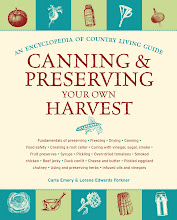Friday, November 2, 2012
Preparing for Winter: Ways to Keep the House Warm While Saving Energy
Summer is manageable just about anywhere. It's the other three seasons, especially winter, that you want to really prepare for. You have to prepare to keep warm and also keep fed. (There's not much wild food forage outdoors in February.) Yet you, me, and everybody else could get along with a lot less heat if we had to.
The Stove. When you heat with wood, the fire goes out in the stove or fireplace after you go to bed. (The fire builder in cold weather is every morning's hero!) I was raised that way, and I live that way. There are ways to keep warm, and in this section I'm passing them on. Check the damper on your wood-burner to make sure it's closed, so you won't lose heat up the chimney. If your heat stove is in the kitchen, a nice wide, high doorway--about twice or more the usual width, with no door of course--will help heat circulate into an adjoining room where you want it, such as your living room. (For lots more on stoves, wood, etc. see Chapter 6.)
Newspaper Uses. If getting firewood is a problem, have you considered burning newspapers? You can roll them up tightly and make your own sort of presto log. You can make an emergency blanket for the bed out of them too.
The Bathroom. This is an important room. People using the bathroom immensely appreciate warmth. If pipes are not at risk of freezing, close off the bathroom and heat it only when needed. You can put a little quick-response electric space heater in there, if you have electricity, to be turned on only when someone is using the room. But if you have water pipes in the bathroom that might freeze and burst (and that can happen if it gets cold enough, even if you leave the water running), then keeping the pipes warm enough is even more important than keeping people warm! If you leave water running, it is less likely to freze; running water can withstand a lot more cold before freezing up than can standing water in the pipes. The colder it is, the larger the volume of water you must keep running to keep it from freezing. Let it run in both your kitchen and bathroom.
HOUSE INSULATING
Windows. If you're cold and don't have heavy thermal drapes that can completely cover your windows, hang heavy-textured blankets over them. Wave your hand slowly around suspicious areas--such as around the side of your windows and above and below your doors--to find out where cold drafts are coming in. Then plug those holes by tacking or taping newspaper or plastic over the windows and adding an insulating lining to the edges of the door. Storm windows on the outside of windows help insulate. If you don't have the regular glass kind of storm window, improvise by nailing a layer of heavy, clear plastic over the outside of all windows. Tack it down all the way around the outside edges of the window, nailing strips of cardboard or thin wood on top of the plastic to prevent it from ripping off in strong winds. We do this every fall and take it off every spring. With the plastic storm windows on the outside and heavy curtains on the inside, not much heat is lost.
Doors. If you don't have an enclosed porch to buffer the air flow between outside and inside the house every time that door opens, install storm doors to hold in your heat. (Even with a porch, they're a good idea.) Make sure the storm doors have good springs so they will stay tightly shut. You don't need but one door in the wintertime. Seal off the others and you'll save heat. Frances E. Render of Billings, Montana (where it gets really cold) wrote me a great "dire emergency" method for sealing doors and windows that let cold in around the edges: Tear cloth strips, wring them out in water, and poke them in those drafty cracks. As they freeze, they will expand and make a perfect seal. Frances has used this trick "on the north side during temperatures of -30 to -40° F with a strong wind and it worked great!" It helps to have a porch-type enclose outside with one operating door.
Sealing Off Spaces. If you don't have doors on the pantry, closets, and similar non-lived-in spaces that don't need to be heated, hang blankets or plastic curtains over their openings. Seal off as many infrequently used rooms as you can for the duration of the cold weather. Keep the bedroom doors shut so you don't have to heat those rooms during the daytime. For more ideas, read Superinsulated Houses and Air-to-Air Heat Exchangers by William A. Shurcliff.
If you do all these things, and your fire is burning fine, by now you ought to be feeling warmer. Still cold? Try the Eskimo technique for keeping warm. Always wear lots of clothes, each rich food, and take a dog to bed--a nice furry variety. If you're still cold, take two dogs to bed, or three. If you're still cold--get married! If that doesn't do it, I give up!
[Adapted from the "Living Simply 'Primitively'" section of Chapter 1: Oddments. Illustration copyright 1994 by Cindy Davis.]









No comments:
Post a Comment